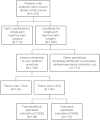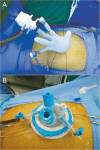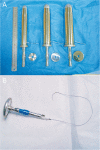A novel single-port laparoscopic operation for colorectal cancer with transanal specimen extraction: a comparative study
- PMID: 25633605
- PMCID: PMC4328051
- DOI: 10.1186/1471-2482-15-10
A novel single-port laparoscopic operation for colorectal cancer with transanal specimen extraction: a comparative study
Abstract
Background: Extension of a single incision for the purpose of specimen extraction in single-port laparoscopic surgery (SPLS) can undermine the merits of SPLS, either by hurting cosmesis or by increasing wound morbidity.
Methods: We retrospectively analyzed the clinical outcomes of patients undergoing SPLS sigmoidectomy, either with transanal specimen extraction (TASE, n = 15) or transumbilical specimen extraction (TUSE, n = 68), for colorectal cancer between March 2009 and March 2013. The inclusion criterion was a tumor diameter of ≤ 5 cm. The median follow-up was 93 months (range 13 - 149).
Results: Most of intraoperative and postoperative variables were comparable between the two groups, except for lengthening of operation time in TASE (287 ± 87 min vs. 226 ± 78 min, P = 0.011). TUSE did not lengthen the duration of postoperative recovery, hospital stay, or pain, or increase the incidence of postoperative complications. Whereas TUSE showed 8.8% (6/68) of wound-related complications, TASE did not show wound-related complications during follow-up period (P = 0.586).
Conclusion: With the exception of a prolonged operation time, TASE showed equivalent surgical outcomes as TUSE in SPLS sigmoidectomy. Thus, the implement of TASE is expected to provide one way of reducing wound-related complications in SPLS in patients with a tumor diameter of ≤5 cm.
Figures






Similar articles
-
Left colon resection with transrectal specimen extraction: current status.Tech Coloproctol. 2018 Jun;22(6):411-423. doi: 10.1007/s10151-018-1806-1. Epub 2018 Jun 12. Tech Coloproctol. 2018. PMID: 29948523 Review.
-
Totally laparoscopic sigmoid colectomy with transanal specimen extraction.Surg Endosc. 2011 Oct;25(10):3459-63. doi: 10.1007/s00464-011-1716-z. Epub 2011 May 7. Surg Endosc. 2011. PMID: 21553173
-
Single-port laparoscopic total mesorectal excision with transanal resection (transabdominal transanal resection) for low rectal cancer: initial experience with 22 cases.Int J Surg. 2013;11(9):858-63. doi: 10.1016/j.ijsu.2013.08.003. Epub 2013 Aug 17. Int J Surg. 2013. PMID: 23962662
-
Totally Laparoscopic Colectomy with Intracorporeal Side-to-End Colorectal Anastomosis and Transrectal Specimen Extraction for Sigmoid and Rectal Cancers.Ann Surg Oncol. 2016 Apr;23(4):1164-8. doi: 10.1245/s10434-015-4984-3. Epub 2015 Nov 23. Ann Surg Oncol. 2016. PMID: 26597363
-
Overview of single-port laparoscopic surgery for colorectal cancers: past, present, and the future.World J Gastroenterol. 2014 Jan 28;20(4):997-1004. doi: 10.3748/wjg.v20.i4.997. World J Gastroenterol. 2014. PMID: 24574772 Free PMC article. Review.
Cited by
-
A modified technique of transanal specimen extraction in the laparoscopic anterior rectal resection for upper rectal or lower sigmoid colon cancer: a retrospective study.BMC Surg. 2021 Feb 12;21(1):82. doi: 10.1186/s12893-021-01085-7. BMC Surg. 2021. PMID: 33579251 Free PMC article.
-
Left colon resection with transrectal specimen extraction: current status.Tech Coloproctol. 2018 Jun;22(6):411-423. doi: 10.1007/s10151-018-1806-1. Epub 2018 Jun 12. Tech Coloproctol. 2018. PMID: 29948523 Review.
-
Colorectal resection via natural orifice specimen extraction versus conventional laparoscopic extraction: a meta-analysis with meta-regression.Tech Coloproctol. 2021 Jan;25(1):35-48. doi: 10.1007/s10151-020-02330-6. Epub 2020 Aug 26. Tech Coloproctol. 2021. PMID: 32851500 Review.
References
Pre-publication history
-
- The pre-publication history for this paper can be accessed here: http://www.biomedcentral.com/1471-2482/15/10/prepub
Publication types
MeSH terms
LinkOut - more resources
Full Text Sources
Other Literature Sources
Medical

